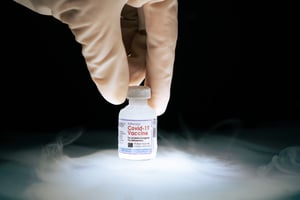 Refrigeration fun fact: Electrically powered air conditioning, which relies on the principle of the refrigeration cycle, was invented not to make homes and other buildings comfortable in hot weather, but to control the temperature and humidity in a printing shop. The lithography process that was common in the early 1900s could be adversely affected by variations in temperature and humidity, so William Carrier invented a device to keep those factors stable.
Refrigeration fun fact: Electrically powered air conditioning, which relies on the principle of the refrigeration cycle, was invented not to make homes and other buildings comfortable in hot weather, but to control the temperature and humidity in a printing shop. The lithography process that was common in the early 1900s could be adversely affected by variations in temperature and humidity, so William Carrier invented a device to keep those factors stable.
It wasn’t long before people realized that the technology could be used to cool homes, offices, warehouses, and factories and reduce indoor humidity.
The refrigeration cycle rarely makes headlines anymore. But in 2020 it became an important topic because the first COVID-19 vaccines required storage and transportation at cold temperatures.
We’re talking cold: The Pfizer vaccine must be kept at -70° Celsius (94 degrees below zero in Fahrenheit, for those who don’t speak metric). That’s colder than the coldest temperatures found at the South Pole.
At higher temperatures, components in the vaccine start to break down, rendering them useless. Ensuring they stay cold from the time they’re manufactured until they’re ready for injection is a top priority for everyone in the “cold chain.”
What Is the Cold Chain?
The cold chain is a specialized supply chain that deals with the manufacture and distribution of goods that need to be kept at low temperatures. The typical use case for the cold chain is food, in particular dairy, meats, some types of produce, and all kinds of frozen foods.
Less well known are the cold chain requirements in the medical field, including some medicines, certain medical test kits, and almost all vaccines (not just those for COVID-19).
Keeping vaccines at -70°C requires specialized equipment. You won’t find freezers capable of those temperatures for sale in retail stores. But keeping them cold in storage is one thing; making sure they remain cold during transportation to patients is an even bigger challenge. It would be impractical to send a person with a thermometer to accompany each shipment.
For this, we need the internet of things (IoT). Network-connected environmental monitoring devices (including those for temperature, humidity, atmospheric pressure, ambient oxygen, and more) are a common IoT application, both for items in storage and those in transit.
IoT Temperature Monitoring for Storage
A wide variety of temperature monitoring systems for cold storage are available. A typical system has the following components:
- Temperature sensors – Probes are placed inside the freezer or refrigerator. Sensors can be powered by an AC adapter or battery and usually have a display that shows various temperature metrics and alert conditions. They either communicate with a monitoring server over Wi-Fi or use a non-Wi-Fi wireless signal to communicate with a receiver unit.
- Receiver unit – Communicates with sensors and connects to the monitoring server over Wi-Fi or Ethernet.
- Monitoring server – Records the data from the sensors and sends alerts to humans (by phone, text, or email) when there are abnormal temperature or communication issues. The server also hosts a web application that enables humans to monitor and manage the entire system.
Everything in an IoT temperature monitoring system is designed to be failsafe: Sensors can have redundant power supplies and can store temperature readings if communication with the server is broken. The server is often deployed in a high-availability configuration with a backup server that can take over if the primary server fails.
IoT Temperature Monitoring In-Transit
Monitoring the temperature of goods in transit is trickier than for those in storage because it’s not always possible for a sensor to maintain communication while traveling in a shipping container, rail car, truck trailer, or airplane.
The cold chain uses portable temperature loggers that are placed inside the container of products being transported. These battery-powered devices record the temperature at regular intervals for the duration of the shipment. Some temperature loggers are single-use and others can be reset, recharged, and reused again and again.
Upon arrival and removal from the package, they either establish a wireless connection (by Bluetooth or some other protocol) to report the temperature data or are connected to a computer by USB for reading.
Either way, the users at the receiving end can use the data to verify the products remained within a safe temperature range throughout the journey, or reject the shipment if it got too warm for too long.
At one time, if you were shipping something that had to stay cold, you just took it on faith that it would stay cold throughout the journey. Now shippers and customers can have hard data that shows the temperature from beginning to end.
Other Applications of Temperature Loggers
Data loggers are not just for monitoring the temperature of vaccines in transit. There are other applications as well, such as:
- Developing and testing new kinds of insulated shipping containers, ice chests, thermal mugs, and more
- Monitoring temperature, chemical components, and cell activity in bioreactors
- Monitoring temperatures at various points of machines, such as automobile and jet engines, during development or troubleshooting
- Monitoring the temperature and other aspects of human organs being transported for transplant
The emergence of inexpensive, accurate portable and stationary IoT sensors provides a wealth of data that was previously difficult or impossible to obtain. In the case of the vaccine cold chain, these devices can give doctors and caregivers assurance that the vaccines they administer will be effective and improve patient outcomes.
The Role of AndPlus In the Cold Chain
AndPlus has had an important part to play in developing data logger technology. We leveraged our IoT expertise to help Onset Computer Corporation develop the software for their end-to-end cold-chain monitoring and alerting system.
We can help you with your IoT project as well; whether for cold-chain monitoring or any other application that requires portable data communication. Give us a call and let’s discuss how we can bring your IoT idea to life.

















